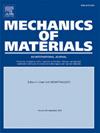Modeling stress evolution during fiber oxidation
IF 3.4
3区 材料科学
Q2 MATERIALS SCIENCE, MULTIDISCIPLINARY
引用次数: 0
Abstract
The paper examines stress evolution in oxidizing ceramic fibers, specifically focusing on silica scales growing on silicon carbide (SiC) fibers. Oxidation leads to the formation of oxide scales that induce significant stresses due to the molar volume expansion during oxidation. These stresses can lead to cracking of the oxide scale and reduction in fiber strength. To model these phenomena, an analytical framework is developed to describe stress evolution in cylindrical fibers. The elastic-creep behavior of the oxide is represented by a viscoelastic Maxwell model. By solving the governing ordinary differential equations (ODEs) and applying material properties relevant to the oxidation of SiC fibers, the study provides insights into the interplay between oxide growth, stress relaxation, and fiber geometry. The findings show that a single material parameter—encompassing fiber radius, oxidation rate, and oxide viscosity—dominates the stress evolution. The study also reveals approximate closed-form solutions for hoop and axial stresses, which match well with results from finite element analyses. These stresses are found to depend strongly on environmental conditions, with higher stress developing in steam compared to dry air. The results provide new insights into potential stress-induced fracture in oxidizing SiC fibers, with implications for high-temperature applications of ceramic materials.
模拟纤维氧化过程中的应力演化
本文研究了氧化陶瓷纤维中的应力演化,特别关注了生长在碳化硅(SiC)纤维上的二氧化硅鳞片。氧化导致氧化鳞片的形成,由于氧化过程中摩尔体积的膨胀而引起显著的应力。这些应力会导致氧化皮的开裂和纤维强度的降低。为了模拟这些现象,开发了一个分析框架来描述圆柱形纤维中的应力演化。氧化物的弹性蠕变行为用粘弹性麦克斯韦模型表示。通过求解控制常微分方程(ode)并应用与SiC纤维氧化相关的材料特性,该研究提供了对氧化物生长,应力松弛和纤维几何形状之间相互作用的见解。研究结果表明,单一的材料参数——包括纤维半径、氧化速率和氧化物粘度——主导了应力演化。研究还揭示了环向和轴向应力的近似封闭解,与有限元分析结果吻合较好。这些应力在很大程度上取决于环境条件,与干燥空气相比,蒸汽中的应力更高。该结果为氧化SiC纤维潜在的应力致断裂提供了新的见解,对陶瓷材料的高温应用具有重要意义。
本文章由计算机程序翻译,如有差异,请以英文原文为准。
求助全文
约1分钟内获得全文
求助全文
来源期刊

Mechanics of Materials
工程技术-材料科学:综合
CiteScore
7.60
自引率
5.10%
发文量
243
审稿时长
46 days
期刊介绍:
Mechanics of Materials is a forum for original scientific research on the flow, fracture, and general constitutive behavior of geophysical, geotechnical and technological materials, with balanced coverage of advanced technological and natural materials, with balanced coverage of theoretical, experimental, and field investigations. Of special concern are macroscopic predictions based on microscopic models, identification of microscopic structures from limited overall macroscopic data, experimental and field results that lead to fundamental understanding of the behavior of materials, and coordinated experimental and analytical investigations that culminate in theories with predictive quality.
 求助内容:
求助内容: 应助结果提醒方式:
应助结果提醒方式:


